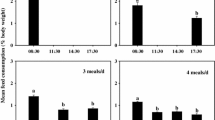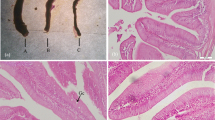Abstract
This study aimed to elucidate the effect of partial or complete replacement of live feed (LF) (Tubifex) with formulated feed (FF) on the reproductive performance of Betta splendens. Three hundred B. splendens fry (average weight 0.19 ± 0.01 g) were equally distributed into five different groups, each with three replicates. They were fed for 105 days with following different diets: control (C)—100% LF; T1—75% LF, 25% FF; T2—50% LF, 50% FF; T3—25% LF, 75% FF, and T4—100% FF. Results showed that the average number of hatched larvae (654 ± 101) and fry survival after 2 weeks of rearing (428 ± 70), after completion of three spawning, were recorded highest in the control group, which was, however, not significantly different from the T1, T2, and T3 groups. At the end of the feeding trial, the highest hatching percentage (90.3%) was registered in the T2 group, which was not significantly different from the control and T1 groups. The T2 group also recorded highest fry survival (65.54%) after completion of three spawning, which was not significantly (P < 0.05) different from the T1 and T3 groups. Control diet contained higher saturated fatty acid (63.23%) than formulated diet (29.80%). In the whole-body tissue, highest level of EPA (0.42%) and DHA (3.13%) were found in the T4 group followed by T3 group. The DHA/EPA ration was recorded highest in the T2 group (10.96%), which did not differ significantly from the T1 and T3 groups. Significant positive correlation was observed between saturated fatty acid levels in fish whole-body tissue and number of hatched larvae (Y = 30.81 × −825.3, R 2 = 0.968) and fry survival after 2 weeks of rearing (Y = 21.38 × −580.9, R 2 = 0.967). Considering all these factors, it can be concluded that the live feed Tubifex can be replaced up to 50% without any adverse effect on the reproductive performance and fry survival of B. splendens.
Similar content being viewed by others
References
AOAC (2005) Official methods of analysis of AOAC international, 18th edn. AOAC International, Gaithersburg
APHA (American Public Health Association) (1995) Standard methods for the examination of water and wastewater, 19th edn. New York, pp 1–47
Baenninger R (1984) Consequences of aggressive threats by Betta splendens. Aggress Behav 10(1):1–9
Clotfelter ED, Curren LJ, Murphy CE (2006) Mate choice and spawning success in the fighting fish Betta splendens: the importance of body size, display behavior and nest size. Ethology 112(12):1170–1178
Fernandez-Palacios H, Izquierdo MS, Robaina L, Valencia A, Salhi M, Vergara J (1995) Effect of n-3 HUFA level in broodstock diets on egg quality of gilhead seabream (Sparus auratus L.). Aquaculture 132:325–337
Folch J, Lees M, Sloane-Stansely GH (1957) Simple method for isolation and purification of total lipids from animal tissues. J Biol Chem 226:497–507
Francis DS, Turchini GM, Jones PL, De Silva SS (2006) Effects of dietary oil source on growth and fillet fatty acid composition of Murray cod, Maccullochella peelii peelii. Aquaculture 253:547–556
Furuita H, Tanaka H, Yamamoto T, Suzuki N, Takeuchi T (2002) Effects of high levels of n-3 HUFA in broodstock diet on egg quality and egg fatty acid composition of Japanese flounder, Paralichthys olivaceus. Aquaculture 210:323–333
Furuita H, Hori K, Suzuki ST, Yamamoto T (2007) Effect of n-3 and n-6 fatty acids in broodstock diet on reproduction and fatty acid composition of broodstock and eggs in the Japanese eel Anguilla japonica. Aquaculture 267:55–61
Henrotte E, Kaspar V, Rodina M, Psenicka M, Linhart O, Kestemont P (2010) Dietary n-3/n-6 ratio affects the biochemical composition of Eurasian perch (Perca fluviatilis) semen but not indicators of sperm quality. Aquac Res 41:e31–e38
Izquierdo MS, Fernandez-Palacios H, Tacon AGJ (2001) Effect of broodstock nutrition on reproductive performance of fish. Aquaculture 197:25–42
Jaroensutainee M, Jaroensutainee K (2001) Bubble nest characteristics of wild Siamese fighting fish. J Fish Biol 58:1311–1319
Jaya-Ram A, Kuah MK, Lim PS, Kolkovski S, Chien CS (2008) Influence of dietary HUFA levels on reproductive performance, tissue fatty acid profile and desaturase and elongase mRNAs expression in female zebrafish Danio rerio. Aquaculture 277:275–281
Kruger DP, Britz PJ, Sales J (2001) The influence of live feed supplementation on growth and reproductive performance of swordtail (Xiphophorus helleri Heckel, 1848) broodstock. Aquar Sci Conserv 3:265–273
Li YY, Chen WZ, Sun ZW, Chen JH, Wu KG (2005) Effects of n-3 HUFA content in broodstock diet on spawning performance and fatty acid composition of eggs and larvae in Plectorhynchus cinctus. Aquaculture 245:263–272
Ling S, Roshada H, Sagiv K, Chong ASC (2006) Effect of varying dietary lipid and protein levels on growth and reproductive performance of female swordtails Xiphophorus helleri (Poeciliidae). Aquac Res 37:1267–1275
Mazorra C, Bruce M, Bell JG, Davie A, Alorend E, Jordan N, Rees J, Papanikos N, Porter M, Bromage N (2003) Dietary lipid enhancement of broodstock reproductive performance and egg and larval quality in Atlantic halibut (Hippoglossus hippoglossus). Aquaculture 227:21–33
Miller MR, Nichols PD, Carter CG (2007) Replacement of dietary fish oil for Atlantic salmon parr (Salmo salar L.) with a stearidonic acid containing oil has no effect on omega-3 long-chain polyunsaturated fatty acid concentrations. Comp Biochem Physiol B 146:197–206
Mukhopadhyay PK, Rout SK (1996) Effects of dietary lipids on growth and tissue fatty acid changes in fry of the carp Catla catla (Hamilton). Aquac Res 27:623–630
New MB (1998) Global aquaculture: current trends and challenges for the 21st century. In: Anans do Aquacultura Brasil 98, vol I. Nov 2–6, Recife
Pigott GM, Tucker BB (1987) Science opens new horizons for marine lipids in human nutrition. Food Rev Int 3:105–138
Seiliez I, Panserat S, Corraze G, Kaushik S, Bergot P (2003) Cloning and nutritional regulation of a Δ6-desaturase-like enzyme in the marine teleost gilthead seabream (Sparus aurata). Comp Biochem Physiol 135B:449–460
Stansby ME (1990) Nutritional properties of fish oil for human consumption-early developments. In: Stansby ME (ed) Fish oils in nutrition. Van Nostrand Reinhold, New York, pp 268–288
Steffens W (1997) Effects of variation feeds on nutritive in essential fatty acids in fish value of freshwater fish for humans. Aquaculture 151:97–119
Suquet M, Normant Y, Gaignon JL, Quemenener L, Fauvel C (2005) Effcet of water temperature on individual reproductive activity of pollack (Pollachius pollachius). Aquaculture 243:113–120
Takeuchi T, Watanabe T (1982) The effects of starvation and environmental temperature on proximate and fatty acid composition of carp and rainbow trout. Bull Jpn Sot Sci Fish 48:1307–1316
Tamaru CS, Cole B, Bailey R, Brown C, Ako H (2001) A manual for commercial production of the swordtail, Xiphophorus helleri. CSTA Publication number 128:16 (Honolulu, Hawaii)
Vasagam KPK, Shanmugam A, Rajagopal S (2007) Dietary effect on fry production and growth performance of sailfin molly, Poecilia latipinna, in salt water. Acta Ichthyologica Et Piscatoria 37(1):29–35
Watanabe T, Vassallo-Agius R (2003) Broodstock nutrition research on marine finfish in Japan. Aquaculture 227:35–61
Yamada K, Kobayashi K, Yone Y (1980) Conversion of linolenic acid to w3-highly unsaturated fatty acids in marine fishes and rainbow trout. Bull Jpn Sot Sci Fish 46:1231–1233
Zheng X, Tocher DR, Dickson CA, Bell JG, Teale AJ (2004) Effects of diets containing vegetable oil on expression of genes involved in highly unsaturated fatty acid biosynthesis in liver of Atlantic salmon (Salmo salar). Aquaculture 236:467–483
Acknowledgment
The first author is thankful to the Director, Central Institute of Fisheries Education (ICAR), Mumbai, India, for providing facilities and the Vice-chancellor, Central Agricultural University, Imphal, India, for granting permission to carry out the research.
Author information
Authors and Affiliations
Corresponding author
Rights and permissions
About this article
Cite this article
Mandal, S.C., Kohli, M.P.S., Das, P. et al. Effect of substituting live feed with formulated feed on the reproductive performance and fry survival of Siamese fighting fish, Betta splendens (Regan, 1910). Fish Physiol Biochem 38, 573–584 (2012). https://doi.org/10.1007/s10695-011-9539-3
Received:
Accepted:
Published:
Issue Date:
DOI: https://doi.org/10.1007/s10695-011-9539-3




